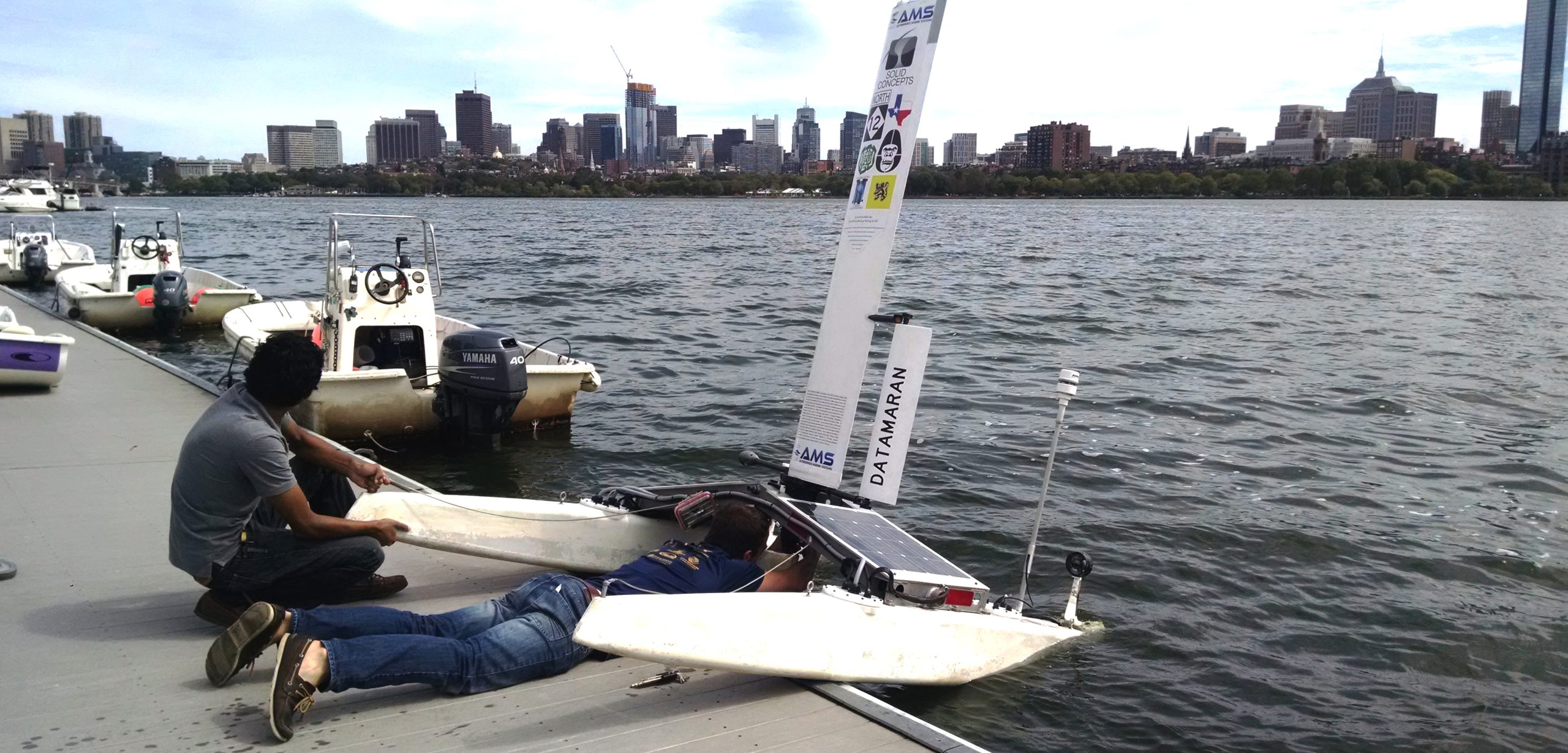Flying Dutchman 2.0
This robotic catamaran could bring the Internet to the depths of the ocean—and turn a tidy profit for its inventors. There’s just one problem.
Article body copy
In theory, the Datamaran is simple: it’s an unmanned robotic sailboat, powered by photovoltaic panels and a white plastic sail, that’s designed to travel the ocean almost indefinitely, like a miniature, technological Flying Dutchman.
The Datamaran’s two hulls, each the size of a stubby kayak, are connected by metal struts strung with ropy black electrical cables. The whole thing, which today is mounted on a metal stand at the Massachusetts Institute of Technology’s Sailing Pavilion, weighs just 85 kilograms, about the bulk of an Olympic heavyweight boxer, and stands about 2.3 meters tall—or it would if the mast hadn’t been torn off and laid on the wooden pier as two frantic engineers scramble to patch together a last-minute fix to the system that directs the sail into the wind.*
In about an hour, a potential investor in Autonomous Marine Systems (AMS), the company that’s building the Datamaran, is coming by to see the craft sail. AMS’s director of engineering, Andrew Punnoose, looks absolutely haggard as he cuts into the mast’s casing with a hacksaw—a Hail Mary attempt to get the boat back on the water in time for the demo.
The company’s CEO, Eamon Carrig, on the other hand, radiates a perpetual chill that clashes with Punnoose’s palpable anxiety. “This sail is a wonderful hybrid of 17th-century technology and 21st-century technology,” he says, cracking his knuckles for emphasis.
The Datamaran, which Carrig has been working on for nearly a decade, is his answer to the astonishing vastness of the ocean. Right now, if you want to make detailed measurements of the ocean—such as the wind or chemical composition of the water—you can peer down at its blue expanse through a satellite; or look up data from the existing Argo network, a system of sensor-laden floats that detect the current, salinity, and temperature at about 4,000 points across the sea. But if you want more detail than that, you’ll probably need to hire a ship.
The Datamaran, Carrig says, will fundamentally change that. Today, there is just one (temporarily broken) Datamaran, but soon—if investors can be convinced—there could be hundreds or even thousands.
Carrig’s plan is to build a whole fleet of the little boats, each of which will make a great—potentially intercontinental—circuit over the vast darkness of the ocean, day and night, returning to port only every six months or so for maintenance. During those lonely journeys, each Datamaran will use a bank of sensors to take detailed measurements of the wind and current, the air pressure, the acidity and salinity of the water, and possibly more. When the fleet finally sails, Carrig says, each Datamaran may even carry Doppler radar equipment. An acoustic modem on the keel will collect data from sensors deep in the ocean that can currently only be communicated with by a human crew floating directly above.
Effectively, the plan is to extend the Datamarans’ web to the farthest reaches—and, potentially, to the yawning depths—of the ocean. “We don’t want to make the app,” Carrig said later. “We want to make the Internet. If you create bandwidth, people will find things to do with it.”
All that data could be used to better predict deadly storms, track the movements of ocean creatures, or assess the long-term effects of oil spills. It could even help oceanographers better model the fluid and chemical dynamics of the ocean writ large. Unlike Argo, a Datamaran could be sent to a specific location, or outfitted with special sensors for a particular mission.
Researchers seem cautiously optimistic about the prospect. “My gut feeling is that it might not be transformative, but it could have the potential to become transformative,” says Raffaele Ferrari, a professor of oceanography at MIT who’s not involved with AMS, but is familiar with the Datamaran project.
The biggest problem—current technical concerns aside—is that AMS’s first customers are likely to be oil companies, which would use the boats to collect data from seismic sensors on the ocean floor, or the military, which could be interested in surveillance applications. Either one, Carrig worries, could try to forbid the company from sharing the Datamarans’ data with researchers, crushing his idyllic, Internet-styled scientific revolution in the process.
“We’re very wary of that,” he says, speaking carefully. “The deals we’ve signed haven’t done that. It’s sort of the same question as whether we’d sell. I really do think the world needs this, and that we’re on the cutting edge of that need.”
Back at MIT, the investor is due to arrive in just 20 minutes. Punnoose has cut open the mast and adjusted a part inside, and now he and Carrig are fixing the sail back onto the Datamaran and hefting the boat into the choppy water, where it lands with a hollow splash. A colossal spider, distressed by the sudden movement, clambers along a cable, and Punnoose sloshes it into the water. We watch the boat sail serenely to a waypoint on the other side of the river, between Storrow Lagoon and the Harvard Bridge, where it holds position by tracing lazy figure eights, now just a speck in the distance.
“Hmm,” Carrig says, testing the wind with his finger. “It’s a nice day for sailing.”
*This sentence has been updated for clarity.

